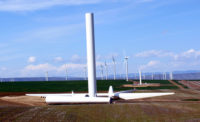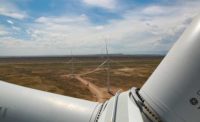With wind turbine projects in 18 states, renewable energy developer Iberdrola has experienced a wide spectrum of site conditions, but those at its $400-million, 208-MW Amazon Wind Farm US East project are unlike anything the firm has ever encountered. Located south of the Great Dismal Swamp in northeastern North Carolina, the project site spans nearly 22,000 acres of drained swampland in Perquimans and Pasquotank counties.
“This area used to be underwater,” says Erik Lallum, Iberdrola’s vice president of construction. “As agriculture built up in the area, ditches and waterways were installed to drain the land so they could farm it productively. We’re building on a geophysical structure that we’ve never built on before.”
The land was drained more than a century ago, creating a thick layer of peat and organic material at the surface that can range up to 12 ft deep. Like a dry sponge, the soils can easily soften and become less stable when wet, creating conditions that are both structurally and logistically challenging. Lallum says that, although the site has historically never taken a direct hit from a hurricane, it is often affected by tropical storms. “This area receives a high level of moisture each year,” he notes.
When completed in December, the project will feature 104 wind turbines, making it the largest wind farm in the southeastern U.S.
North Carolina Gov. Pat McCrory noted the importance of the Iberdrola project in a July 2015 groundbreaking ceremony, stating that “bringing onshore wind production to North Carolina is part of my ‘all-of-the-above’ energy strategy. By diversifying our energy resources, we can provide affordable, reliable and secure sources of energy that are environmentally clean and safe.”
Each turbine site on the sprawling project will feature a 2-MW Gamesa G114 turbine with a 374-ft rotor diameter and three 182-ft-long blades. The turbines will be set upon 305-ft towers. At maximum height, including the blade at full upward extension, the turbines will reach 492 ft.
West Fargo, N.D.-based Wanzek Construction—a division of MasTec—is building the project under an engineering-procurement-construction (EPC) contract. PAR Electrical Contractors, Kansas City, Mo., is handling all electrical work under a separate contract.
Given the soil conditions, each tower requires significant foundation work. Lallum says crews excavate between 10 and 12 ft down from the surface to reach below the peat layer, where soils often include a mix of sand and clay.
“We’ve had to employ multiple techniques to dewater the area around the foundations,” he says. “We installed dewatering mechanisms anywhere from 15 feet to 20 feet below our excavation depth in order to start foundations.”
Built on a spread footer system, the average foundation has a base diameter of 67 ft and a height of 6 ft. Atop each base sits the tower pedestal with a diameter of 19 ft and a height of 4 ft 6 in. With a total height of 10 ft 6 in., roughly 6 in. is above ground. Each foundation requires 577 cu yd of 5,000-psi concrete—done in a single pour—and 48 tons of steel rebar.
At completion, the total project will install more than 60,000 cu yd of concrete and nearly 5,000 tons of steel for the 104 foundations.
The site also required construction of access roads. “We’ve used atypical methods for road building, including a geogrid structural material with aggregate,” Lallum says. “We also used several techniques for cement stabilization and lime stabilization in order to build up the strength on the roadways.”
The unstable surface required extensive use of mud mats around each tower pad for staging crews, equipment and materials. This is particularly critical for movement and staging of cranes, including two 750-ton primary erection cranes.
By late April, 17 foundations and about 85% of the site’s roads were complete. Roads are expected to finish in May, with foundation work wrapping up in late June.
As foundations are finished, the crews are ramping up efforts to install towers and turbines. Lallum says that turbine deliveries will begin in late May with installation starting in early June and extending through October. He says that, while the team would like to have a just-in-time delivery approach, that would be logistically risky. “You can plan for things to come up, but some things are too unpredictable,” he says. “Road construction, weather, trip permits and accidents on the road all cause delays.”
Turbines will be shipped in through nearby ports and transported by truck or barge. All turbines will need to travel at least a mile on public roads to reach the site. “Each turbine includes a 220,000-pound cell,” Lallum says. “The transportation equipment is something to be seen. It’s a tractor-trailer that is approximately 240 ft in length and 16 ft wide. It has 11 axles under the trailer, each with an individual turning mechanism.”
Once it reaches the site, Lallum says the tractor-trailer cannot travel across the mud mats or roads. All cells must be loaded onto off-road vehicles to transport them to each pad site. When crews begin turbine installation, Lallum says they will be sequenced in an assembly-line fashion, as each subassembly crew works down a row of pads. Lallum says crews are divided by “the crane that they work with.” Each base- and mid-tower crew does its erection work, then it moves to the next pad. The topping crew is next in line followed by the rotor assembly crew. Eventually, Lallum says the site will have two main erection cranes—each with their own sets of subassembly crews—working separate rows of pads.
At peak workforce, the site is expected to have around 250 workers on site. While staff and some specialty workers will be brought in, Lallum says the majority of workers will be local. Since most have not worked on wind turbines before, he says the schedule is built with a learning curve in place. After training workers, the first turbines will serve as an opportunity to prove those skills.
“It’s done slowly and deliberately to make sure the planning was complete and everyone understands the work that’s being done; then they start to go quicker,” Lallum says. “During the first week, we might only install one or two turbines. By the fourth week, we hope to be at our target of six turbines per week. We will maintain that until completion.”
Although hurricane season ramps up in late summer through the fall, Lallum says the team is prepared to weather any storms. “We think the overall risk is small,” he adds.
Commissioning work is scheduled to start in September, with all turbines ready to go online by December. The wind farm will tie into the electrical grid via a station built by Dominion Power, the project’s interconnectivity utility. Under a power purchase agreement, Amazon will purchase 100% of power from the wind farm for use in its data centers and other facilities.
Paul Copleman, spokesperson for Iberdrola, says the site was initially proposed for 150 turbines. “We still view that those additional 46 turbines as a potential Phase 2 that we’re still actively developing,” he says.






Post a comment to this article
Report Abusive Comment